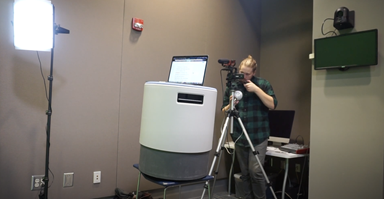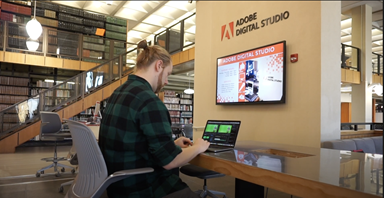Cameraphone Composition: Documentary Filmmaking as Civic-Rhetorical Action in First-Year Composition
by Jacob D. Richter | Xchanges 16.1, Spring 2021
Contents
The Retold Histories of Clemson
The Process: Making Documentary Videos in the FYC Classroom
The Retold Histories of Clemson: Three Documentary Films
Behind the Scenes”: Access, Accessibility, & Audiences
Appendix A: Assignment Prompt for The Retold Histories of Clemson Project
The Process: Making Documentary Videos in the FYC Classroom
Two sections of Clemson University’s FYC course worked on films for The Retold Histories of Clemson in the Fall 2018 semester, and two sections of the same course the following Spring semester viewed this original work and used it as a heuristic to inspire their own additions to the project. The FYC program at Clemson University instituted a requirement during the 2018-2019 academic year mandating not only a multimodal project within the course, but also a project theme of “The History of Clemson University Multimodal Argument.” Altogether, the four sections created the multimedia documentary projects comprising The Retold Histories of Clemson, borrowing cameras, tripods, lighting equipment, shooting space, and expertise from a variety of campus institutions and resources. As a whole, the project demonstrates a design in which rhetorical action functions to assemble publics through both multimodal composition and civic engagement.
Each course section began the unit, our final chronological component of the course, by viewing some of the materials assembled by the Call My Name project. Having just finished a unit on academic argumentation and deliberative rhetoric, students were encouraged to transfer this persuasive mindset into a multimedia format, but also to begin considering creative, imaginative, and narrative potentials not wholly supported within conventional academic writing assignments such as the written research essay. To become more familiar with the genre of the documentary, students viewed clips of popular documentary films such as Gabriela Cowperthwaite’s Blackfish and Spike Lee’s When The Levees Broke, paying particular attention to genre conventions such as voiceover tone, footage angle, narrative style, lighting, expert interviewing, and storytelling devices.
Students continued the introductory research process by exploring digital materials surrounding the See the Stripes movement that foregrounds Clemson University’s inconsistent grappling with racial issues in recent years (Carson, 2017). Additionally, students examined materials related to Clemson University’s historically inconsistent acknowledgement of its past along with video resources researching local histories such as Legacies of Fort Hill (O’Brien et al., 2016) and The Ghosts of Pendleton (O’Brien, 2016). Students then toured buildings on Clemson’s campus which were constructed by the labor of enslaved African Americans, and finally discussed campus activist movements of the past half-decade, including the proliferation of the social media hashtag #BeingBlackAtClemson and the 2016 sit-in at a campus building by five members of the See the Stripes campaign. Students discussed these resources both as a class and in small group settings, as well as in an online forum, and eventually formed groups to discuss not only which of the stories or events were of the most interest to them, but also how these histories were told, which groups or institutions various tellings and re-tellings were serving, and who they thought was benefitting in moments when Clemson’s history with slavery and racial injustice was glossed over or sanitized to protect the university’s ethos.

After viewing the resources surrounding the university community’s history and discussing primary conventions of the documentary film genre, students collaboratively discussed and eventually decided upon a story, moment, narrative, fact, problem, event, or person that they wanted to chronicle in their documentary film. From a pedagogical perspective, it was important for students to have the agency to tell the stories they wanted to tell, rather than the stories they felt their instructor or institution wanted them to tell. Student voice and agency are integral for projects drawing upon participatory culture, and among the goals in challenging students to create a film all their own was to challenge them to reflect critically upon their own experiences, privileges, and understandings of their local communities, and ultimately to use this critical thought as an interventional mechanism for the creation of their documentary. In many projects that engage socially progressive initiatives, some students as well as community stakeholders may not feel their individual political beliefs are being represented or are being included fairly and inclusively. In other words, students who aren’t initially inclined to make public statements critiquing institutional racism, structural inequality, or historical injustice may at times in a project setting such as this feel that their instructors are attempting to silence their voices. Situations such as these are difficult to navigate. In cases such as these, it can be helpful to focus on local issues and histories rather than national political ideologies. Issues more centrally located within the scope of the project, such as in this case Clemson’s deeply troubling history with slavery, help to orient students and instructors toward the same goals, values, and objectives

In other words, it is helpful for us as instructors to help students through self-critique and analysis of institutions they might believe in, and to guide students through the separation between caring deeply for an institution and uncritical loyalty to it. This process opens up the possibility for deep appreciation for an institution while still acknowledging and condemning the atrocities an institution has committed. Social justice pedagogies have a long and impactful history, and scholars have dedicated considerable resources to theorizing, designing, and practicing strategies in which to respond to systemic, ingrained injustices in higher education curricula (Chapman and Hobbel, 2010; Poe, Inoue, and Elliot, 2018; Condon and Young, 2018). Some even suggest that multimodal composing may help us to pluralize linguistic diversity in our communication practices, support multilingual students, and rewrite how we understand public spaces (Pütz & Mundt, 2019). The onus is, ultimately, on instructors to discuss white supremacy, institutional racism, and structural inequality, and to resist it in our pedagogies. The multimedia project detailed here represents one such attempt to do so, though it is only one strategy to directly confront these issues within a multitude of options (Berila, 2015).
 Download PDF
Download PDF